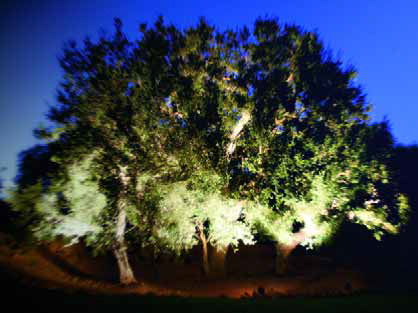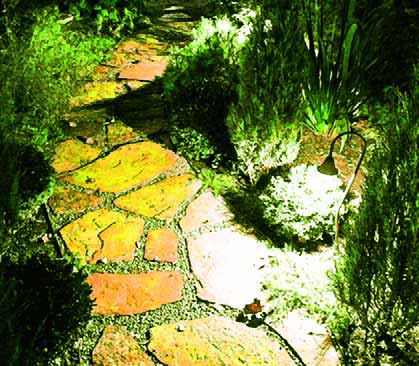Outdoor Living, Fire Features, Amenities & Lighting
As I see it, successful landscape lighting is a two-part process: First, the designer applies aesthetic principles that create the art, then he or she supports that artistic vision with scientific and technological savvy. One without the other doesn’t work: You can’t effectively practice the art until you’ve mastered the science. In my 17 years as a lighting designer, I’ve encountered lots of professionals who have the artistic part of the equation down pat but fall well short when it comes to working with electricity. The plain fact is, you can use the best fixtures in the world and understand the aesthetic issues like the back of your hand, but if you can’t consistently deliver power to those fixtures at correct, reliable voltages, the overall system will not perform properly and has the potential to become a maintenance nightmare. There’s no way a single article can bring anyone up to speed with all of the issues involved in the science lighting. Instead, my intention here is to introduce watershapers to a basic, commonsense approach to laying out low-voltage, halogen lighting systems, the goal being to enable you to converse intelligently and persuasively with lighting designers in the interest of helping
Although the eye is commonly drawn to structures and other architecture elements found in any given exterior environment, very often it is trees that serve as visual anchors in modern landscapes. Indeed, they tend to be the largest objects on most properties and will often become focal points even in settings in which they might have started out in supporting roles. This dominance or even potential for dominance is why, as a lighting designer, I believe that trees should always receive
Those of us who are designers and builders of full-scale outdoor environments (you know who you are) face a distinct challenge: In our work for our clients, we are expected to provide the outline and details for a huge range of project elements, from watershapes and patios to plantings and walkways and more. That list, at least so far as clients are concerned, also includes appropriate lighting, but that is not always something on which we focus. Indeed, lighting design is seen as a specialty even by those who tackle almost every other project feature - and there's no problem with that unless
Those of us who are designers and builders of full-scale outdoor environments (you know who you are) face a distinct challenge: In our work for our clients, we are expected to provide the outline and details for a huge range of project elements, from watershapes and patios to plantings and walkways and more. That list, at least so far as clients are concerned, also includes appropriate lighting, but that is not always something on which we focus. Indeed, lighting design is seen as a specialty even by those who tackle almost every other project feature - and there's no problem with that unless
Landscape-lighting design is my obsession: Not only do I make my living at it, but it has also reached a point where it informs the way I look at every landscape and watershape I encounter - whether I'm working on those spaces or not. When I visit almost any site - and particularly when I spot an interesting garden - I almost instantaneously begin formulating ideas about how I'd light it. That's a good thing, because it keeps me professionally sharp, but it's also a bit addictive: Once you start visualizing how dynamic particular places can be when properly lit, you get hooked on the mental exercise and start enjoying the intensity of the experience. In the beginning, of course, those clear visualizations
Landscape-lighting design is my obsession: Not only do I make my living at it, but it has also reached a point where it informs the way I look at every landscape and watershape I encounter - whether I'm working on those spaces or not. When I visit almost any site - and particularly when I spot an interesting garden - I almost instantaneously begin formulating ideas about how I'd light it. That's a good thing, because it keeps me professionally sharp, but it's also a bit addictive: Once you start visualizing how dynamic particular places can be when properly lit, you get hooked on the mental exercise and start enjoying the intensity of the experience. In the beginning, of course, those clear visualizations
The most famous artists and designers often become known for one particular style or motif. When we see the cubism of Pablo Picasso or the drip paintings of Jackson Pollack, for example, we firmly link those distinctive artistic "moves" with the artists themselves. In some cases, those associations are extremely positive and add to the artist's or designer's mystique and prestige - certainly the case with Picasso and Pollack. For other artists who are less famous, however, an identifiable mode of expression can lead to confinement, predictability and, in some cases, a needless limitation of vision and creative possibilities. Since I began my career in the early 1980s, I've focused on capturing aquatic life forms in mixed-media sculptures to such an extent that my name is associated with the genre - although I'm certainly no Picasso. Indeed, in the years I've been active, there have been so many sculptures, statues and paintings depicting whales, dolphins and fish that the genre I love has become something of a cliché. So many consumers love such images that a vast number of enterprising artists have stepped in to meet the demand. The problem is that so many of these efforts are uninspired and
From the streets of London to the forbidding environs of horror movies, fog has always been capable of stirring our imaginations. It's the stuff clouds are made of and an enduring symbol of mystery, and it's not too surprising that enterprising people would try to figure out how to generate and use this most elemental of atmospheric vapors as a practical tool and distinctive design element. To start our story, let's flash back to 1970, when the first-ever artificial-fog system made its debut at the World's Fair in Osaka, Japan, as part of Pepsi's revolutionary Pavilion of the Clouds. Just a year earlier, my father, cloud expert Tom Mee, had founded Mee Industries to provide instrumentation that was to enable the government to do a better job of studying clouds and airborne pollution. I can only imagine what it was like for him to receive a call from Japanese artist Fujiko Nakaya, who asked him to develop a system that would generate a cloud to would enfold the outside of a 200-foot dome as a key element of her design for the pavilion. Interestingly, Nakaya was the daughter of the man who had pioneered snowmaking technology, and I've always been intrigued that she wanted to make a
As part of my work on movies and television shows through the past dozen years, I've developed a range of special effects that focus specifically on fire. For the science fiction hit Men In Black, for example, I was charged with devising the flame-spewing weapons wielded by Tommy Lee Jones and Will Smith in a spectacular scene in which they shoot down a flying saucer. That system involved a range of safety issues along with devising a specially formulated fuel (alcohol mixed with various metals) to create blue flames as well as a combination of inert gases and electronic control systems that were used to extinguish the fire and protect the actors. As is the way with so much in Hollywood, an on-screen sequence that lasts just a couple of seconds took my team
When we work in public settings, the basic demand on lighting designers is for straightforward fixture layouts capable of providing enduring effects and requiring minimal ongoing attention. That doesn't sound particularly exciting - and it's not, unless the lighting designer uses it as a baseline and reaches above and beyond.Parks, plazas, resorts and historical sites (among many others) are all spaces that really should come alive at night, but their lighting designs often run counter to that vitality by being so utilitarian that they spark boredom rather than energy. It's easy to understand why this happens: Because such spaces play host to high levels of traffic and often multiple uses, they demand lighting treatments that




















